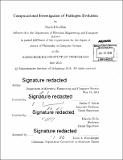| dc.contributor.advisor | Pardis C. Sabeti and Manolis Kellis. | en_US |
| dc.contributor.author | Sealfon, Rachel (Rachel Sima) | en_US |
| dc.contributor.other | Massachusetts Institute of Technology. Department of Electrical Engineering and Computer Science. | en_US |
| dc.date.accessioned | 2015-11-09T19:53:30Z | |
| dc.date.available | 2015-11-09T19:53:30Z | |
| dc.date.copyright | 2015 | en_US |
| dc.date.issued | 2015 | en_US |
| dc.identifier.uri | http://hdl.handle.net/1721.1/99858 | |
| dc.description | Thesis: Ph. D., Massachusetts Institute of Technology, Department of Electrical Engineering and Computer Science, 2015. | en_US |
| dc.description | Cataloged from PDF version of thesis. | en_US |
| dc.description | Includes bibliographical references (pages 105-118). | en_US |
| dc.description.abstract | Pathogen genomes, especially those of viruses, often change rapidly. Changes in pathogen genomes may have important functional implications, for example by altering adaptation to the host or conferring drug resistance. Accumulated genomic changes, many of which are functionally neutral, also serve as markers that can elucidate transmission dynamics or reveal how long a pathogen has been present in a given environment. Moreover, systematically probing portions of the pathogen genome that are changing more or less rapidly than expected can provide important clues about the function of these regions. In this thesis, I (1) examine changes in the Vibrio cholerae genome shortly after the introduction of the pathogen to Hispaniola to gain insight into genomic change and functional evolution during an epidemic. I then (2) use changes in the Lassa genome to estimate the time that the pathogen has been circulating in Nigeria and in Sierra Leone, and to pinpoint sites that have recurrent, independent mutations that may be markers for lineage-specific selection. I (3) develop a method to identify regions of overlapping function in viral genomes, and apply the approach to a wide range of viral genomes. Finally, I (4) use changes in the genome of Ebola virus to elucidate the virus' origin, evolution, and transmission dynamics at the start of the outbreak in Sierra Leone. | en_US |
| dc.description.statementofresponsibility | by Rachel Sealfon. | en_US |
| dc.format.extent | 118 pages | en_US |
| dc.language.iso | eng | en_US |
| dc.publisher | Massachusetts Institute of Technology | en_US |
| dc.rights | M.I.T. theses are protected by copyright. They may be viewed from this source for any purpose, but reproduction or distribution in any format is prohibited without written permission. See provided URL for inquiries about permission. | en_US |
| dc.rights.uri | http://dspace.mit.edu/handle/1721.1/7582 | en_US |
| dc.subject | Electrical Engineering and Computer Science. | en_US |
| dc.title | Computational investigation of pathogen evolution | en_US |
| dc.type | Thesis | en_US |
| dc.description.degree | Ph. D. | en_US |
| dc.contributor.department | Massachusetts Institute of Technology. Department of Electrical Engineering and Computer Science | |
| dc.identifier.oclc | 927715792 | en_US |
